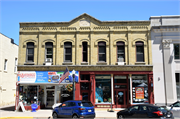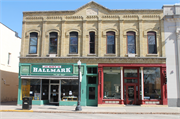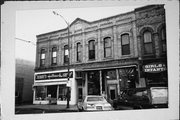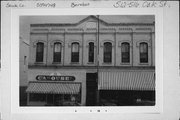| Additional Information: | A large fire in 1878 destroyed much of the Oak Street block facing the courthouse square. A new brick double-block was constructed in 1879 by George Holah for J.J. Gattiker. The woodwork was done Thomas Thompson and the building cost approximately $6,000. A triangular pediment marks the center of the seven by two story design and highlighted with a central stone block that reads: “Gattiker 1879.” Brick provides the sole ornamentation. Window hoods are segmented arches and bricks are used to create dentils at the first story and roof and columns between the windows. Plate glass windows, iron columns, sidelights and transom are all largely unaltered on the southern storefront located at 512 Oak Street. The northern storefront, however, has been altered extensively, but still maintains a recessed entry.
James Jacob Gattiker was born in Zurich, Switzerland in 1826 and taught French, Italian and Mathematics as a professor until 1855, when his entire family immigrated to the United States. In 1858, J.J. Gattiker, and his brother Alfred, settled in Baraboo and opened a hardware store. The Gattiker brothers were responsible for the development and construction of many of the buildings around the courthouse square during the 1870s and 1880s, providing materials and financing. J.J. Gattiker, in particular, was leader of the local community, convincing many German speaking immigrants to settle in the Baraboo area and providing social and financial assistance. He retired from business in 1886.
In 1880, August Fisher moved his drug store to the 516 Oak Street address and named the store the Fisher’s Brother’s Drug Store. The Fisher Brother’s installed a plate glass storefront in 1889. The store was known for its innovation, utilizing a road medicine wagon in the 1890s and installing a two-story soda fountain in 1891. The store was sold to employees in 1913 and continued as a drug store. In the 1920s the store constructed a new exterior storefront and extensive interior work including a 1925 Frigidaire soda fountain. The drug store was bought out by the rival Thompson Drug Store in the 1970s and closed.
The southern storefront, located at 512 Oak Street, was occupied by the Pfannstiehl Dry Goods and Grocery upon completion. Emil Pfannstiehl was married to one of J.J. Gattiker’s daughters. In 1892, the storefront was occupied by Mould and Buckley Book Store and Cigars. The store became the Buckley and Taylor Book Store in 1906. The structure has continually been treated as two stores, as have many of the other double blocks in downtown Baraboo. In 1879, the Baraboo Republic newspaper moved their quarters into the second floor of the new Gattiker Block. Several organizations used the upper hall in the building, including the Grand Army of the Republic, the Ladies Art Society, and the Baraboo Choral Union. |
|---|
| Bibliographic References: | City of Baraboo Directory records on file with the Sauk County Historical Society.
Ward, Joseph Wayne. Baraboo, 1850-2010, Vol. IV: Chronology of the Growth of the Commercial & Retail Districts. Self-published, 2013.
Wolter, Paul. ‘Downtown Pharmacies,’ presentation notes.
Wolter, Paul. Notes collected for tours of Downtown Baraboo. Multiple dates. |
|---|




